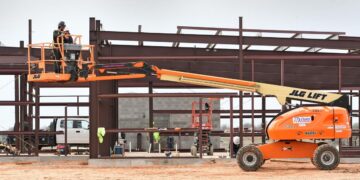Lawton-Fort Sill Regional Airport’s budget for next year reflects the reality of decreasing American Rescue Plan Act funding, but also the fact that pilots can be expected to buy more fuel for their aircraft.
Members of the airport’s governing board put their stamp of approval on the budget last week, a document that reflects $3.4 million in anticipated income for the 12-month period that begins July 1 and $3.017 million in projected expenses over the same timeframe. The net effect is projected to be almost $400,000 more in revenue than expenses.
David Madigan, chairman of the Lawton Metropolitan Area Airport Authority, said ARPA funding is down — $860,000 for the coming year, versus $1.258 million this fiscal year — and so is car rental income (the percentage of revenue that car rental companies pay to the airport). That ARPA loss is the biggest gap in rental revenue, while car rental commissions are projected to be $70,600 less in the coming year ($475,000, versus $545,600 this year).
Ironically, the drop in car rental revenue is tied to the growing health of airlines.
Airport Director Barbara McNally said industry experts indicated that as the COVID-19 pandemic continued, it played havoc with flight schedules, so many travelers opted to rent cars and drive to their destinations rather than fly. That trend is reversing as more Americans return to the skies and Lawton is following that trend: McNally said American Eagle managers in Lawton last week were pleased “with how energized our load factors are”, in terms of passengers flying out of Lawton.
McNally has said load factors are a key in keeping all of Lawton’s daily flights, and the airport continues to post full and nearly-full flights on weekends and healthy numbers the rest of the week.
On the expenditure side, the airport’s largest expenditure in the coming year will be under Lawton Aviation Services (which handles flights in and out of the airport). LAS is projecting it will spend $1 million in the coming year on Jet A fuel, $650,000 more than it expected to spend this fiscal year. But, that is good news: the airport buys the fuel to refuel aircraft coming into and leaving its facility, and airport officials anticipate more military flights will be buying fuel.
“We’ll make $250,000 in profit on that $1 million,” McNally said, of the cost of buying the fuel, versus the cost of selling it.
McNally and Madigan said most other expenditures for the airport are expected to remain similar to those for the year that ends June 30. One exception will be legal/professional costs, which is increasing by $50,000.
“Legal expenses are difficult to project,” McNally said, referring to legal help needed as the airport pursues a lawsuit against everyone involved in building Fire Station No. 2 on the airport’s northern boundary.
That station, opened in early 2020, began experiencing cracking soon after its opening and and the airport authority voted in January to file suit alleging breach of agreement against the contractors and engineers involved with the $4.4 million project. McNally said the lawsuit was initiated to determine who is responsible for the problem, which officials have said apparently stems from movement of the clay soil under the structure.
The suit has meant increasing legal costs for the airport, to a decision this week by the airport authority to hire a forensic engineer to help with the lawsuit.
Want to reach a local audience and grow your business?
Our website is the perfect platform to connect with engaged readers in your local area.
Whether you're looking for banner ads, sponsored content, or custom promotions, we can tailor a package to meet your needs.
Contact us today to learn more about advertising opportunities!
CONTACT US NOW




